史上最全的小学英语思维导图知识点共29页文档共31页
- 格式:ppt
- 大小:2.55 MB
- 文档页数:31
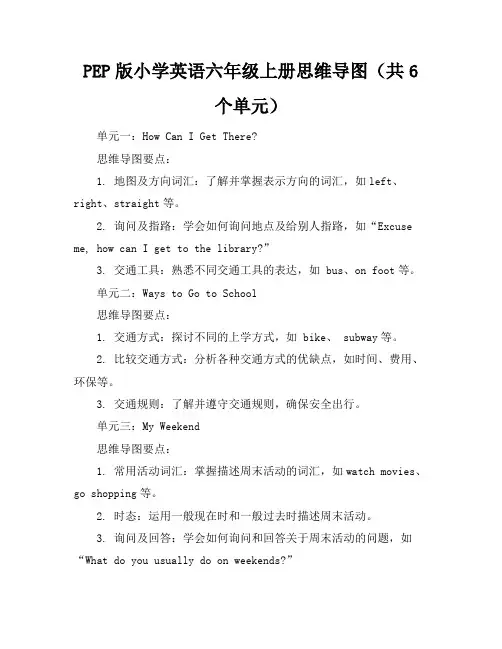
PEP版小学英语六年级上册思维导图(共6个单元)单元一:How Can I Get There?思维导图要点:1. 地图及方向词汇:了解并掌握表示方向的词汇,如left、right、straight等。
2. 询问及指路:学会如何询问地点及给别人指路,如“Excuse me, how can I get to the library?”3. 交通工具:熟悉不同交通工具的表达,如 bus、on foot等。
单元二:Ways to Go to School思维导图要点:1. 交通方式:探讨不同的上学方式,如 bike、 subway等。
2. 比较交通方式:分析各种交通方式的优缺点,如时间、费用、环保等。
3. 交通规则:了解并遵守交通规则,确保安全出行。
单元三:My Weekend思维导图要点:1. 常用活动词汇:掌握描述周末活动的词汇,如watch movies、go shopping等。
2. 时态:运用一般现在时和一般过去时描述周末活动。
3. 询问及回答:学会如何询问和回答关于周末活动的问题,如“What do you usually do on weekends?”单元四:I Have a Pen Pal思维导图要点:1. 介绍笔友:学习如何介绍自己的笔友,包括姓名、年龄、爱好等。
2. 书信格式:掌握英文书信的格式,如日期、称呼、、结束语等。
3. 描述国家特色:了解并描述不同国家的特色,如食物、景点、文化等。
单元五:What's the Weather Like?思维导图要点:1. 天气词汇:掌握描述天气的词汇,如sunny、rainy、cloudy 等。
2. 询问及回答天气:学会如何询问和回答天气状况,如“What's the weather like in Beijing?”3. 天气预报:了解并解读天气预报,为日常生活做好准备。
单元六:The Olympics思维导图要点:1. 奥运会历史:了解奥运会的发展历程及重要事件。

连词并列连词从属连词1. 表示并列的连词1)and(和)L et's sit down and have a rest.2) neither...nor(既不...也不)N either you nor he is late for school.3) both...and(两者都)T hey can speak both English and French.4)not only...but also(不但...而且)J enny can play not only basketball but alsof ootball.2. 表示选择的并列连词1)or(或者,还是)I s it white or green?2)either...or...(或者...或者)Y ou may either stay here or go with me.3. 表示转折或对比的并列连词b ut(但是)T he skirt is nice, but it's too expensive.4. 表示因果的并列连词1)for(因为)Y ou'd better put on your sweater, for thew eather outside is cold.2)so(因此,所以)M y sister is waiting for me, so I must gon ow.1. 引导时间状语从句1)when/as(当...时候)W hen/As he entered, the hall burst intot hunderous applause.他进场时,大厅里发出雷鸣般的掌声2)before(在...之前)Y ou must clean the room before you leave.3)after(在...之后)I'll go swimming with you after my homework is finished.2. 引导原因状语从句b ecause(因为)3. 引导条件状语从句i f(如果)4. 引导让步状语从句a lthough/though(尽管,虽然)T hey were sad because they lost the match.I f you have any question, please let me know.A lthough/Though he has never been to America, he hass ome American friends.在中文中,我们常说“虽然...但是...”“因为...所以...",而在英文中,although/though和b ut,because和so不能用在同一个句子中。

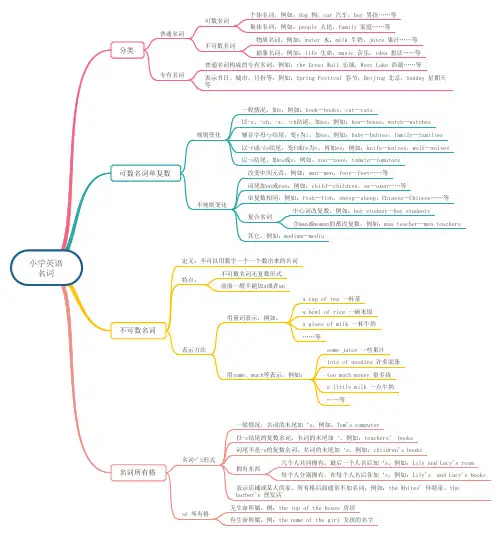
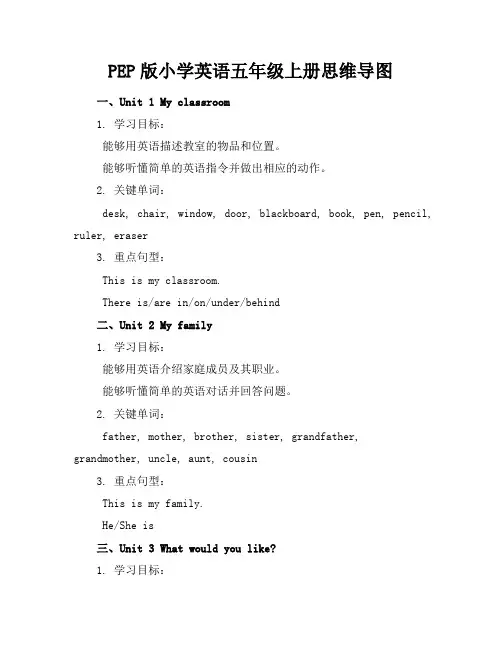
PEP版小学英语五年级上册思维导图一、Unit 1 My classroom1. 学习目标:能够用英语描述教室的物品和位置。
能够听懂简单的英语指令并做出相应的动作。
2. 关键单词:desk, chair, window, door, blackboard, book, pen, pencil, ruler, eraser3. 重点句型:This is my classroom.There is/are in/on/under/behind二、Unit 2 My family1. 学习目标:能够用英语介绍家庭成员及其职业。
能够听懂简单的英语对话并回答问题。
2. 关键单词:father, mother, brother, sister, grandfather, grandmother, uncle, aunt, cousin3. 重点句型:This is my family.He/She is三、Unit 3 What would you like?1. 学习目标:能够用英语询问和回答食物和饮料的喜好。
能够听懂简单的英语对话并做出相应的回答。
2. 关键单词:food, drink, apple, banana, orange, pear, water, milk, juice3. 重点句型:What would you like?I would like四、Unit 4 I can play basketball1. 学习目标:能够用英语描述自己的兴趣爱好。
能够听懂简单的英语对话并回答问题。
2. 关键单词:play, basketball, football, volleyball, swim, dance, sing, draw3. 重点句型:I canHe/She can五、Unit 5 There is a big bed in the bedroom1. 学习目标:能够用英语描述房间和家具的布局。
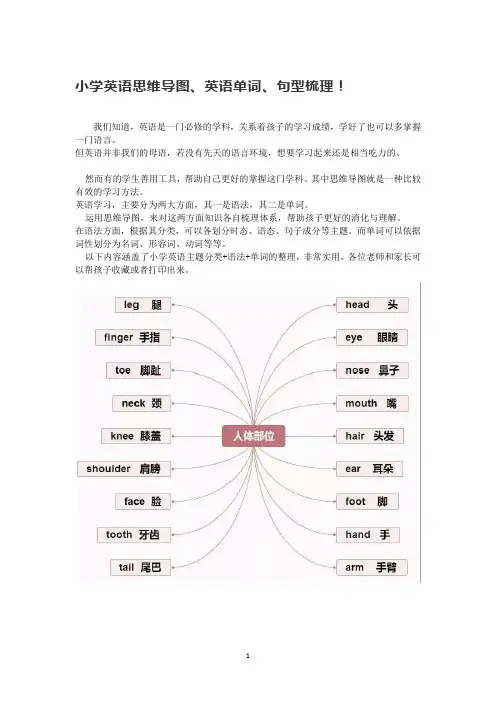
小学英语思维导图、英语单词、句型梳理!
我们知道,英语是一门必修的学科,关系着孩子的学习成绩,学好了也可以多掌握一门语言。
但英语并非我们的母语,若没有先天的语言环境,想要学习起来还是相当吃力的。
然而有的学生善用工具,帮助自己更好的掌握这门学科。
其中思维导图就是一种比较有效的学习方法。
英语学习,主要分为两大方面,其一是语法,其二是单词。
运用思维导图,来对这两方面知识各自梳理体系,帮助孩子更好的消化与理解。
在语法方面,根据其分类,可以各划分时态、语态、句子成分等主题。
而单词可以依据词性划分为名词、形容词、动词等等。
以下内容涵盖了小学英语主题分类+语法+单词的整理,非常实用。
各位老师和家长可以帮孩子收藏或者打印出来。
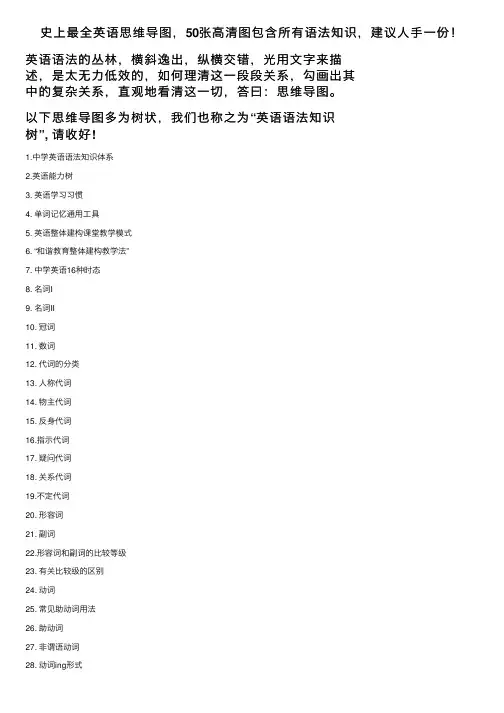
史上最全英语思维导图,50张⾼清图包含所有语法知识,建议⼈⼿⼀份!英语语法的丛林,横斜逸出,纵横交错,光⽤⽂字来描述,是太⽆⼒低效的,如何理清这⼀段段关系,勾画出其中的复杂关系,直观地看清这⼀切,答⽈:思维导图。
以下思维导图多为树状,我们也称之为“英语语法知识树”, 请收好!1.中学英语语法知识体系2.英语能⼒树3. 英语学习习惯4. 单词记忆通⽤⼯具5. 英语整体建构课堂教学模式6. “和谐教育整体建构教学法”7. 中学英语16种时态8. 名词I9. 名词II10. 冠词11. 数词12. 代词的分类13. ⼈称代词14. 物主代词15. 反⾝代词16.指⽰代词17. 疑问代词18. 关系代词19.不定代词20. 形容词21. 副词22.形容词和副词的⽐较等级23. 有关⽐较级的区别24. 动词25. 常见助动词⽤法26. 助动词27. ⾮谓语动词28. 动词ing形式29. 不定式的时态和语态30. 省to 的动词不定式31. 不定式作宾语32. 不定式作补语33. 不定式作主语34. 不定式句法功能35. doing与to do的区别136. doing与to do的区别237. 分词38. 独⽴主格结构39. ⼀般现在时40. ⼀般将来时41. 现在完成时42. ⼀般过去时43. 现在进⾏时44. 时态与时间状语45. 被动语态46. 各种形式的被动语态47. 句⼦的种类48. 反意疑问句49. 反意疑问句记忆规则150.反意疑问句记忆规则2。
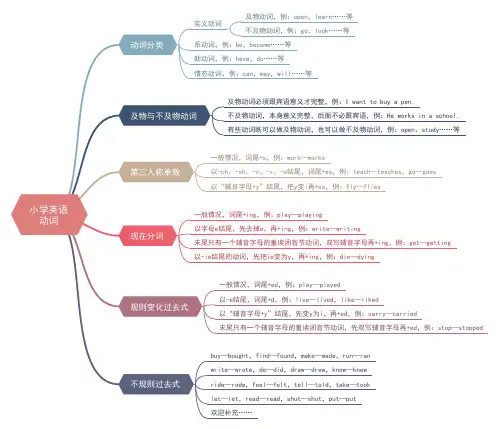
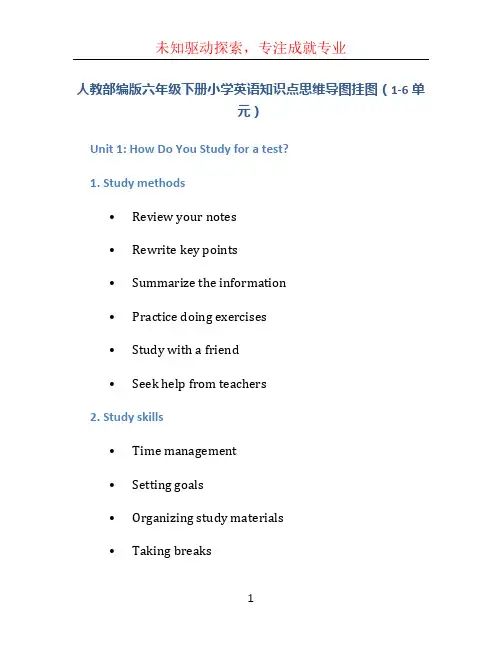
人教部编版六年级下册小学英语知识点思维导图挂图(1-6单元)Unit 1: How Do You Study for a test?1. Study methods•Review your notes•Rewrite key points•Summarize the information•Practice doing exercises•Study with a friend•Seek help from teachers2. Study skills•Time management•Setting goals•Organizing study materials•Taking breaks•Avoiding distractionsUnit 2: What Does He Look Like?1. Physical appearance•Hair color (blond, brown, black)•Eye color (blue, brown, green)•Height (tall, short, medium)•Age (young, old, middle-aged)•Build (slim, chubby, muscular)2. Describing people•Using adjectives (kind, friendly, funny)•Using comparison words (taller than, shorter than)•Using present continuous tense (He is wearing a blue shirt.)•Using possessive pronouns (His sister is tall.)Unit 3: I am more outgoing than my sister.1. Comparatives and Superlatives•Adding -er and -est (taller, tallest)•Doubling the final consonant (bigger, biggest)•Using more and most (more beautiful, most beautiful)•Exceptions and irregular forms (good, better, best) 2. Comparing personalities•Using adjectives (friendly, outgoing, shy)•Using comparatives (more outgoing than, less shy than)•Using superlatives (the most friendly, the least outgoing)Unit 4: What’s the Best Movie Theater?1. Expressing opinions•Using adjectives (good, bad, interesting)•Using comparative adjectives (better, worse, more interesting)•Using superlative adjectives (the best, the worst, the most interesting)2. Asking for opinions•Using question words (What, Which)•Using sentence structure (What is your opinion about…?)•Using polite phrases (Could you tell me…?)Unit 5: Do you Want to Help Clean the City Park?1. Giving and receiving instructions•Using imperatives (Pick up the trash. Plant the flowers.)•Using polite requests (Can you please help me…?)•Using sequencing words (First, then, finally)2. Talking about the environment•Vocabulary related to nature and pollution•Actions to protect the environment (recycle, reduce, reuse)•Discussing the importance of a clean environmentUni t 6: I’m watching TV.1. Present Continuous Tense•Affirmative sentences (I am doing my homework.)•Negative sentences (She is not eating lunch.)•Questions (Are you playing soccer?)•Using time expressions (Right now, at the moment)2. Daily activities•Vocabulary related to daily routines (eat breakfast, brush teeth)•Talking about hobbies and interests•Describing activities using present continuous tense以上是人教部编版六年级下册小学英语知识点思维导图挂图(1-6单元)的概述。
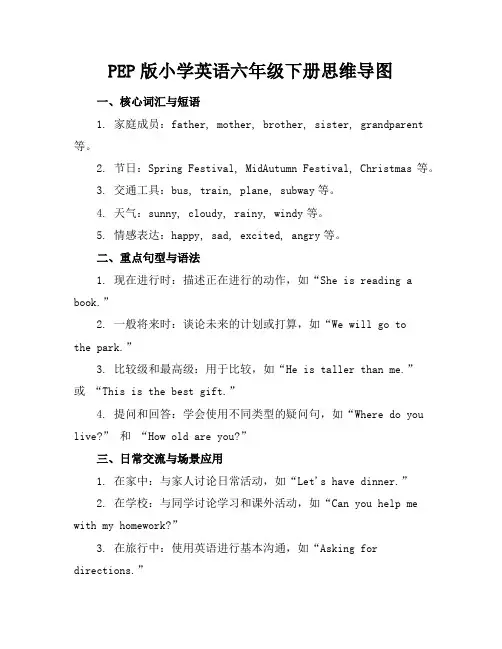
PEP版小学英语六年级下册思维导图一、核心词汇与短语1. 家庭成员:father, mother, brother, sister, grandparent 等。
2. 节日:Spring Festival, MidAutumn Festival, Christmas等。
3. 交通工具:bus, train, plane, subway等。
4. 天气:sunny, cloudy, rainy, windy等。
5. 情感表达:happy, sad, excited, angry等。
二、重点句型与语法1. 现在进行时:描述正在进行的动作,如“She is reading a book.”2. 一般将来时:谈论未来的计划或打算,如“We will go tothe park.”3. 比较级和最高级:用于比较,如“He is taller than me.”或“This is the best gift.”4. 提问和回答:学会使用不同类型的疑问句,如“Where do you live?” 和“How old are you?”三、日常交流与场景应用1. 在家中:与家人讨论日常活动,如“Let's have dinner.”2. 在学校:与同学讨论学习和课外活动,如“Can you help me with my homework?”3. 在旅行中:使用英语进行基本沟通,如“Asking for directions.”四、文化与习俗了解英语国家的文化和习俗也是学习英语的重要部分:1. 西方节日:了解不同节日的庆祝方式,如“Easter”和“Halloween”。
2. 餐桌礼仪:学习西方餐桌上的基本礼仪,如“Please pass the salt.”3. 文化差异:认识到中西方文化的不同,学会尊重和理解。
通过这张思维导图,我们希望学生们能对本册英语知识有一个清晰的整体认识,帮助他们在复习和巩固知识时更加高效。
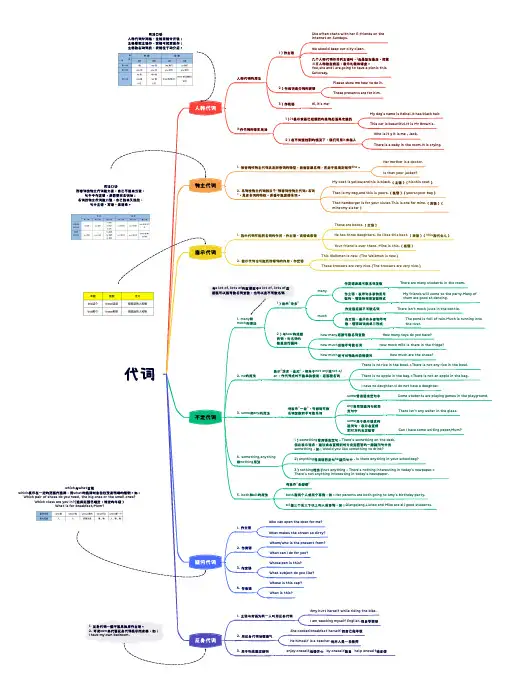
代词人称代词物主代词指示代词不定代词疑问代词反身代词人称代词的用法i t 作代词的常见用法1)作主语2)作动词或介词的宾语3)作表语 She often chats with her E-friends on theI nternet on Sundays.W e should keep our city clean. 几个人称代词作并列主语时,I 总是放在最后,把第二三人称放在前面,表示礼貌和谦虚。
Y ou,she and I are going to have a picnic thisS atursay.P lease show me how to do it.T hese presents are for him.H i,it's me! 用法口诀人称代词分两格,主格宾格分开说;主格要把主语作,宾格可把宾表作;主格放在动词前,宾格位于动介后。
1)it 表示前面已经提到的某物后面再次提到M y dog's name is Heihei.It has black hair.T his car is beautiful.It is Mr Brown's.2)在不知道性别的情况下,我们可用it 来指人W ho is it ?It is me ,Jack.T here is a baby in the room.It is crying.1. 形容词性物主代词具有形容词的特征,后面紧跟名词,前后不能用定冠词the 。
H er mother is a doctor.I s that your jacket? 2. 名词性物主代词相当于“形容词性物主代词+名词”,具有名词的特征,后面不能直接名词。
M y coat is yellow,and his is black.(主语)(his=his coat )T hat is my bag,and this is yours.(表语)(yours=your bag ) That hamburger is for your sister.This is one for mine.(宾语)(m ine=my sister )1. 指示代词可起到名词的作用,作主语、宾语或表语T hose are books.(主语)H e has three daughters. He likes this best.(宾语)(this 指代女儿)Y our friend is over there. Mine is this.(表语)2. 指示代词也可起到形容词的作用,作定语T his Walkman is new. (The Walkman is new.)T hese trousers are very nice.(The trousers are very nice.) 1. many 和m uch 的用法1)表示“许多”m anym uch作定语后跟可数名词复数 作主语,表示许多事物是可数的,谓语动词用复数形式作定语后跟不可数名词 作主语,表示许多事物不可数,谓语动词用单三形式T here are many students in the room.T here isn't much juice in the bottle. My friends will come to the party.Many oft hem are good at dancing. The pond is full of rain.Much is running intot he river. 2)与how 构成疑问词,对名词的数量进行提问h ow many 后接可数名词复数h ow much 后接不可数名词h ow much 还可对物品的价格提问H ow many toys do you have?H ow much milk is there in the fridge?H ow much are the shoes?2. no 的用法 表示“没有,全无”,相当于not any 或not a/a n ,作代词式时不能单独使用,后面接名词T here is no rice in the bowl.=There is not any rice in the bowl.T here is no apple in the bag.=There is not an apple in the bag.I have no daughter.=I do not have a daughter.3. some 和any 的用法 均表示“一些”,可修饰可数名词复数和不可数名词s ome 常用语肯定句中 any 常用语疑问句和否定句中S ome students are playing games in the playground.T here isn't any water in the glass. some 用于表示请求的疑问句,表示希望得到对方的肯定回答C an I have some writing paper,Mum? 4. something,anything和nothing 用法 1)something 常用语肯定句,There's something on the desk.但在表示请求,建议或希望得到对方肯定回答的一般疑问句中用s omething ,如:Would you like something to drink?2) anything 常用语否定句he 疑问句中,Is there anything in your schoolbag? 3)nothing 相当于not anything ,There's nothing interesting in today's newpaper.=T here's not anything interesting in today's newspaper.5. both 和all 的用法均表示“全部都”b oth 指两个人或两个事物,如:Her parents are both going to Amy's birthday party.a ll 指三个或三个以上的人或事物,如:Qiangqiang,Liutao and Mike are all good students. 用法口诀形容词性物主代词能力差,自己不能来当家,句子中作定语,后面要把名词加;名词性物主代词能力强,自己独来又独往,句中主语、宾语、表语当。